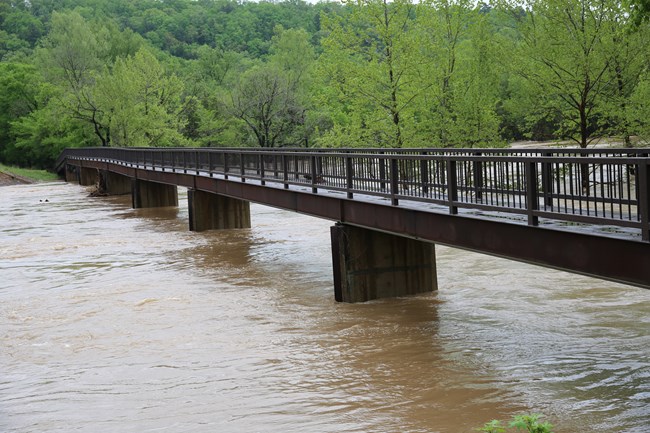|
General climate change impacts for the Midwest include increased seasonal temperatures, increased precipitation in winter/spring, drier summers, and more extreme events of flood/drought. According to the Climate Change Hazards Summary Report for Facility Investment Planning for Ozark National Scenic Riverways (2021), it is anticipated that by mid-century, the mean annual temperatures for the park are projected to rise by 4.7 degrees. The frost-free season will extend by three weeks and there will be 25 more days above 95 degrees in summer and 21 fewer days below 32 degrees in winter. This climate shift will expand the visitation season for an additional month and will place a much higher demand and carrying capacity on campgrounds, roads, trails, restrooms, and river access requirements for the park. Future flood events are projected to increase by 20%, with higher intensities, which will further impact critical visitor infrastructure. The trend of severe flooding events is likely to continue in the future, which could negatively impact stability of river access points, facilities, unpaved roads, and trails in the flood plain. Natural geologic processes, precipitation, and freeze/thaw cycles are forces shaping our roads and trails infrastructure and are expected to increasingly impact this critical infrastructure with climate change. Sedimentation from recurring maintenance of poorly designed unpaved roads, river access sites, and parking areas could impact threatened and endangered mussel species’ critical habitat. 
NPS Flood and climate resiliency can be achieved through: *Improved campground designs to promote shedding of water instead of deposits of silt/gravel after a flood. *Low-profile and water-resilient hook-up stations that are less likely to collect debris and include waterproof electrical components. *Concrete roads and trailer pads that are more resistant to damage from flood waters. *Anchored picnic tables and other site amenities that have low profiles, are sheltered using landscape features, and other flood resistant innovations. *Replacement of traditional stick-frame structures in the flood plain with concrete flood-resistant units that can better withstand extreme floods, are not susceptible to mold, and are easy to clean and maintain. *Better trail and access point design, including improved drainage and better tread material. Since the historic flood of 2017, which had a devastating impact to many structures, roads, trails, campgrounds and river access points in the flood plain, Ozark National Scenic Riverways has been working to incorporate many of the strategies above. 
NPS Photo 
NPS Photo |
Last updated: November 10, 2022
